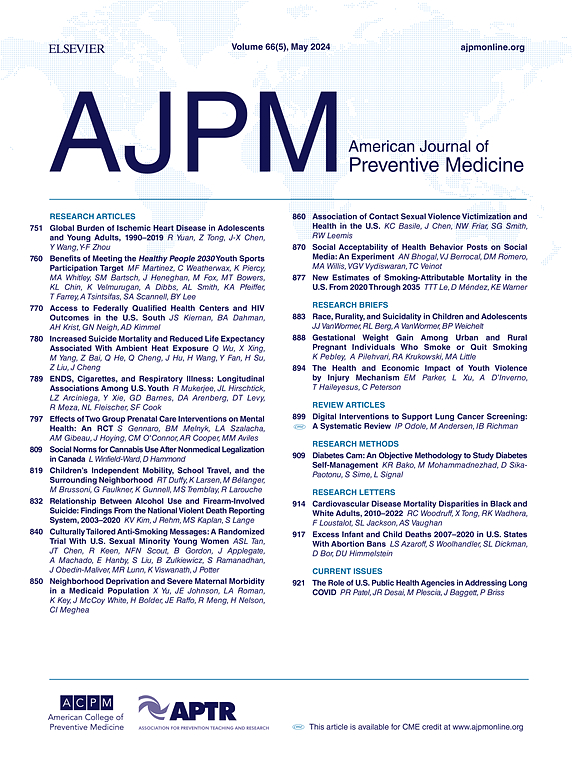中国妇女生命历程、社会经济地位与高危妊娠:来自祖母、母亲及其子女健康研究的证据
IF 4.3
2区 医学
Q1 MEDICINE, GENERAL & INTERNAL
引用次数: 0
摘要
高危妊娠妇女比例的增加已被强调为一项重要的公共卫生挑战。本研究考察了中国孕妇在童年、青年期和婚后生活中母亲的社会经济地位与高危妊娠谱风险之间的关系。方法:本研究使用了2020年至2021年在中国淮安市开展的“祖母、母亲及其子女健康研究”的数据,包括8407名已婚孕妇。高危妊娠根据五色管理框架进行界定,并与产妇信息系统进行链接。利用母亲父母的受教育程度、母亲18岁时的家庭经济地位(指父母的经济地位)、母亲的受教育程度、母亲的职业、丈夫的受教育程度和家庭年收入来构建母亲整个生命历程的社会经济地位。采用Logistic回归模型、Shapley值分解模型和序列中介模型。分析于2024年进行。结果在母亲生命的各个阶段,包括儿童期、青年期和婚后生活,社会经济地位评分与高危妊娠之间存在剂量-反应相关性(p为趋势值<;0.05)。婚姻生活社会经济地位占模型解释力的79.59%,其次是青年期(10.84%)和童年社会经济地位(9.57%)。与社会经济地位一直较高的妇女相比,社会经济地位一直较低的妇女发生高危妊娠的几率更高(OR=1.63, 95% CI=1.32, 2.01)。结论社会经济地位较低的妇女,特别是社会经济地位持续较低的妇女,高危妊娠的风险较高。婚姻生活的社会经济地位占模型解释力的最大部分。在中国实施全面二孩和全面三孩政策时,应考虑从生命历程角度减少社会经济不平等和促进医疗资源的普遍可及性。本文章由计算机程序翻译,如有差异,请以英文原文为准。
Lifecourse Socioeconomic Status and High-Risk Pregnancy in Chinese Women: Evidence From Grandmothers, Mothers, and Their Children’s Health Study
Introduction
The increasing proportion of women with high-risk pregnancy has been highlighted as an important public health challenge. This study examined the associations between maternal socioeconomic status during childhood, young adulthood, and married life and the risk of the spectrum of high-risk pregnancy in Chinese pregnant women.
Methods
This study used data from the Grandmothers, Mothers, and Their Children’s Health study, which was conducted in Huai’an city, China, from 2020 to 2021 and included 8,407 married pregnant women. High-risk pregnancy was defined according to the Five-Color Management framework by linking to the Maternity Information System. Maternal socioeconomic status across the life course was constructed using the educational levels of maternal parents, maternal family economic status at age 18 years (referring to parents’ economic status), maternal educational level, maternal occupation, husband’s educational level, and annual household income. Logistic regression models, the Shapley value decomposition, and the serial mediation model were used. Analyses were conducted in 2024.
Results
There were dose-response associations between socioeconomic status scores and high-risk pregnancy at each stage of maternal life, including childhood, young adulthood, and married life (p for trend<0.05). Married life socioeconomic status accounted for 79.59% of the model’s explanatory power, followed by young adulthood (10.84%) and childhood socioeconomic status (9.57%). Compared with those with consistently high socioeconomic status, women with consistently low socioeconomic status had higher odds of developing high-risk pregnancy (OR=1.63, 95% CI=1.32, 2.01).
Conclusions
Women with lower socioeconomic status across their life-course, particularly those with consistently low socioeconomic status, have a higher risk of high-risk pregnancy. Married life socioeconomic status accounts for the largest portion of the explanatory power of the model. Reducing socioeconomic inequalities from a life-course perspective and promoting universal access to healthcare resources should be considered in the implementation of universal two-child and three-child policies in China.
求助全文
通过发布文献求助,成功后即可免费获取论文全文。
去求助
来源期刊

American Journal of Preventive Medicine
医学-公共卫生、环境卫生与职业卫生
CiteScore
8.60
自引率
1.80%
发文量
395
审稿时长
32 days
期刊介绍:
The American Journal of Preventive Medicine is the official journal of the American College of Preventive Medicine and the Association for Prevention Teaching and Research. It publishes articles in the areas of prevention research, teaching, practice and policy. Original research is published on interventions aimed at the prevention of chronic and acute disease and the promotion of individual and community health.
Of particular emphasis are papers that address the primary and secondary prevention of important clinical, behavioral and public health issues such as injury and violence, infectious disease, women''s health, smoking, sedentary behaviors and physical activity, nutrition, diabetes, obesity, and substance use disorders. Papers also address educational initiatives aimed at improving the ability of health professionals to provide effective clinical prevention and public health services. Papers on health services research pertinent to prevention and public health are also published. The journal also publishes official policy statements from the two co-sponsoring organizations, review articles, media reviews, and editorials. Finally, the journal periodically publishes supplements and special theme issues devoted to areas of current interest to the prevention community.
 求助内容:
求助内容: 应助结果提醒方式:
应助结果提醒方式:


